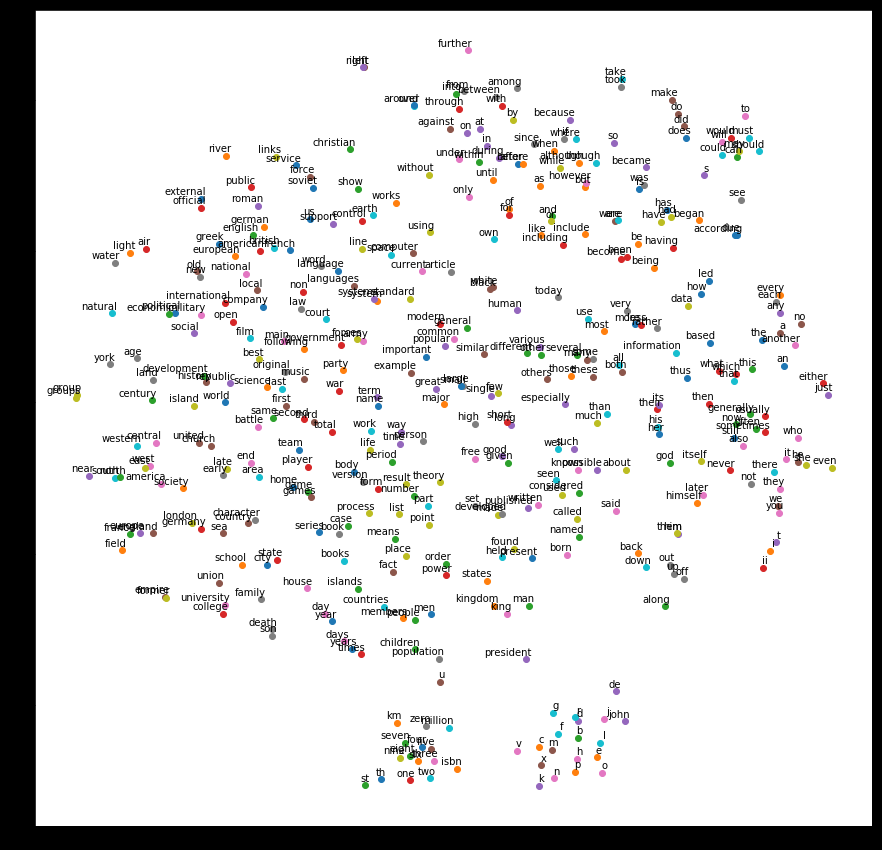关于word2vec的理解,推荐文章https://www.cnblogs.com/guoyaohua/p/9240336.html
代码参考https://github.com/eecrazy/word2vec_chinese_annotation
我在其基础上修改了错误的部分,并添加了一些注释。
代码在jupyter notebook下运行。
from __future__ import print_function #表示不管哪个python版本,使用最新的print语法 import collections import math import numpy as np import random import tensorflow as tf import zipfile from matplotlib import pylab
from sklearn.manifold import TSNE %matplotlib inline
下载text8.zip文件,这个文件包含了大量单词。官方地址为http://mattmahoney.net/dc/text8.zip
filename='text8.zip' def read_data(filename): """Extract the first file enclosed in a zip file as a list of words""" with zipfile.ZipFile(filename) as f: # 里面只有一个文件text8,包含了多个单词 # f.read返回字节,tf.compat.as_str将字节转为字符 # data包含了所有单词 data = tf.compat.as_str(f.read(f.namelist()[0])).split() return data #words里面包含了所有的单词 words = read_data(filename) print('Data size %d' % len(words))
创建正-反词典,并将单词转换为词典索引,这里词汇表取为50000,仍然有400000多的单词标记为unknown。
#词汇表大小 vocabulary_size = 50000 def build_dataset(words): # 表示未知,即不在词汇表里的单词,注意这里用的是列表形式而非元组形式,因为后面未知的数量需要赋值 count = [['UNK', -1]] count.extend(collections.Counter(words).most_common(vocabulary_size - 1)) #词-索引哈希 dictionary = dict() for word, _ in count: # 每增加一个-->len+1,索引从0开始 dictionary[word] = len(dictionary) #用索引表示的整个text8文本 data = list() unk_count = 0 for word in words: if word in dictionary: index = dictionary[word] else: index = 0 # dictionary['UNK'] unk_count = unk_count + 1 data.append(index) count[0][1] = unk_count # 索引-词哈希 reverse_dictionary = dict(zip(dictionary.values(), dictionary.keys())) return data, count, dictionary, reverse_dictionary data, count, dictionary, reverse_dictionary = build_dataset(words) print('Most common words (+UNK)', count[:5]) print('Sample data', data[:10]) # 删除,减少内存 del words # Hint to reduce memory.
生成batch的函数
data_index = 0 # num_skips表示在两侧窗口内总共取多少个词,数量可以小于2*skip_window # span窗口为[ skip_window target skip_window ] # num_skips=2*skip_window def generate_batch(batch_size, num_skips, skip_window): global data_index #这里两个断言 assert batch_size % num_skips == 0 assert num_skips <= 2 * skip_window #初始化batch和labels,都是整形 batch = np.ndarray(shape=(batch_size), dtype=np.int32) labels = np.ndarray(shape=(batch_size, 1), dtype=np.int32) #注意labels的形状 span = 2 * skip_window + 1 # [ skip_window target skip_window ] #buffer这个队列太有用了,不断地保存span个单词在里面,然后不断往后滑动,而且buffer[skip_window]就是中心词 buffer = collections.deque(maxlen=span) for _ in range(span): buffer.append(data[data_index]) data_index = (data_index + 1) % len(data) #需要多少个中心词,因为一个target对应num_skips个的单词,即一个目标单词w在num_skips=2时形成2个样本(w,left_w),(w,right_w) # 这样描述了目标单词w的上下文 center_words_count=batch_size // num_skips for i in range(center_words_count): #skip_window在buffer里正好是中心词所在位置 target = skip_window # target label at the center of the buffer targets_to_avoid = [ skip_window ] for j in range(num_skips): # 选取span窗口中不包含target的,且不包含已选过的 target=random.choice([i for i in range(0,span) if i not in targets_to_avoid]) targets_to_avoid.append(target) # batch中重复num_skips次 batch[i * num_skips + j] = buffer[skip_window] # 同一个target对应num_skips个上下文单词 labels[i * num_skips + j, 0] = buffer[target] # buffer滑动一格 buffer.append(data[data_index]) data_index = (data_index + 1) % len(data) return batch, labels # 打印前8个单词 print('data:', [reverse_dictionary[di] for di in data[:10]]) for num_skips, skip_window in [(2, 1), (4, 2)]: data_index = 0 batch, labels = generate_batch(batch_size=16, num_skips=num_skips, skip_window=skip_window) print(' with num_skips = %d and skip_window = %d:' % (num_skips, skip_window)) print(' batch:', [reverse_dictionary[bi] for bi in batch]) print(' labels:', [reverse_dictionary[li] for li in labels.reshape(16)])
我这里打印的结果为:可以看到batch和label的关系为,一个target单词多次对应于其上下文的单词
data: ['anarchism', 'originated', 'as', 'a', 'term', 'of', 'abuse', 'first', 'used', 'against']
with num_skips = 2 and skip_window = 1:
batch: ['originated', 'originated', 'as', 'as', 'a', 'a', 'term', 'term', 'of', 'of', 'abuse', 'abuse', 'first', 'first', 'used', 'used']
labels: ['as', 'anarchism', 'originated', 'a', 'term', 'as', 'of', 'a', 'term', 'abuse', 'of', 'first', 'abuse', 'used', 'against', 'first']
with num_skips = 4 and skip_window = 2:
batch: ['as', 'as', 'as', 'as', 'a', 'a', 'a', 'a', 'term', 'term', 'term', 'term', 'of', 'of', 'of', 'of']
labels: ['anarchism', 'originated', 'a', 'term', 'originated', 'of', 'as', 'term', 'of', 'a', 'abuse', 'as', 'a', 'term', 'first', 'abuse']
构建model,定义loss:
batch_size = 128 embedding_size = 128 # Dimension of the embedding vector. skip_window = 1 # How many words to consider left and right. num_skips = 2 # How many times to reuse an input to generate a label. valid_size = 16 # Random set of words to evaluate similarity on. valid_window = 100 # Only pick dev samples in the head of the distribution. #随机挑选一组单词作为验证集,valid_examples也就是下面的valid_dataset,是一个一维的ndarray valid_examples = np.array(random.sample(range(valid_window), valid_size)) #trick:负采样数值 num_sampled = 64 # Number of negative examples to sample. graph = tf.Graph() with graph.as_default(), tf.device('/cpu:0'): # 训练集和标签,以及验证集(注意验证集是一个常量集合) train_dataset = tf.placeholder(tf.int32, shape=[batch_size]) train_labels = tf.placeholder(tf.int32, shape=[batch_size, 1]) valid_dataset = tf.constant(valid_examples, dtype=tf.int32) # 定义Embedding层,初始化。 embeddings = tf.Variable(tf.random_uniform([vocabulary_size, embedding_size], -1.0, 1.0)) softmax_weights = tf.Variable( tf.truncated_normal([vocabulary_size, embedding_size],stddev=1.0 / math.sqrt(embedding_size))) softmax_biases = tf.Variable(tf.zeros([vocabulary_size])) # Model. # train_dataset通过embeddings变为稠密向量,train_dataset是一个一维的ndarray embed = tf.nn.embedding_lookup(embeddings, train_dataset) # Compute the softmax loss, using a sample of the negative labels each time. # 计算损失,tf.reduce_mean和tf.nn.sampled_softmax_loss loss = tf.reduce_mean(tf.nn.sampled_softmax_loss(weights=softmax_weights, biases=softmax_biases, inputs=embed, labels=train_labels, num_sampled=num_sampled, num_classes=vocabulary_size)) # Optimizer.优化器,这里也会优化embeddings # Note: The optimizer will optimize the softmax_weights AND the embeddings. # This is because the embeddings are defined as a variable quantity and the # optimizer's `minimize` method will by default modify all variable quantities # that contribute to the tensor it is passed. # See docs on `tf.train.Optimizer.minimize()` for more details. optimizer = tf.train.AdagradOptimizer(1.0).minimize(loss) # 模型其实到这里就结束了,下面是在验证集上做效果验证 # Compute the similarity between minibatch examples and all embeddings. # We use the cosine distance:先对embeddings做正则化 norm = tf.sqrt(tf.reduce_sum(tf.square(embeddings), 1, keep_dims=True)) normalized_embeddings = embeddings / norm valid_embeddings = tf.nn.embedding_lookup(normalized_embeddings, valid_dataset) #验证集单词与其他所有单词的相似度计算 similarity = tf.matmul(valid_embeddings, tf.transpose(normalized_embeddings))
开始训练:
num_steps = 40001 with tf.Session(graph=graph) as session: tf.initialize_all_variables().run() print('Initialized') average_loss = 0 for step in range(num_steps): batch_data, batch_labels = generate_batch(batch_size, num_skips, skip_window) feed_dict = {train_dataset : batch_data, train_labels : batch_labels} _, this_loss = session.run([optimizer, loss], feed_dict=feed_dict) average_loss += this_loss # 每2000步计算一次平均loss if step % 2000 == 0: if step > 0: average_loss = average_loss / 2000 # The average loss is an estimate of the loss over the last 2000 batches. print('Average loss at step %d: %f' % (step, average_loss)) average_loss = 0 # note that this is expensive (~20% slowdown if computed every 500 steps) if step % 10000 == 0: sim = similarity.eval() for i in range(valid_size): valid_word = reverse_dictionary[valid_examples[i]] top_k = 8 # number of nearest neighbors # nearest = (-sim[i, :]).argsort()[1:top_k+1] nearest = (-sim[i, :]).argsort()[0:top_k+1]#包含自己试试 log = 'Nearest to %s:' % valid_word for k in range(top_k): close_word = reverse_dictionary[nearest[k]] log = '%s %s,' % (log, close_word) print(log) #一直到训练结束,再对所有embeddings做一次正则化,得到最后的embedding final_embeddings = normalized_embeddings.eval()
我们可以看下训练过程中的验证情况,比如many这个单词的相似词计算:
开始时,
Nearest to many: many, originator, jeddah, maxwell, laurent, distress, interpret, bucharest,
10000步后,
Nearest to many: many, some, several, jeddah, originator, neurath, distress, songs,
40000步后,
Nearest to many: many, some, several, these, various, such, other, most,
可以看到此时单词的相似度确实很高了。
最后,我们通过降维,将单词相似情况以图示展现出来:
num_points = 400 # 降维度PCA tsne = TSNE(perplexity=30, n_components=2, init='pca', n_iter=5000) two_d_embeddings = tsne.fit_transform(final_embeddings[1:num_points+1, :]) def plot(embeddings, labels): assert embeddings.shape[0] >= len(labels), 'More labels than embeddings' pylab.figure(figsize=(15,15)) # in inches for i, label in enumerate(labels): x, y = embeddings[i,:] pylab.scatter(x, y) pylab.annotate(label, xy=(x, y), xytext=(5, 2), textcoords='offset points', ha='right', va='bottom') pylab.show() words = [reverse_dictionary[i] for i in range(1, num_points+1)] plot(two_d_embeddings, words)
结果如下,随便举些例子,university和college相近,take和took相近,one、two、three等相近

总结:原始的word2vec是用c语言写的,这里用的python,结合的tensorflow。这个代码存在一些问题,首先,单词不是以索引作为输入的,应该是以one-hot形式输入。其次,负采样的比例太小,词汇表有50000,每批样本才选64个去做softmax。然后,这里也没使用到另一个trick(当然这里根本没用one-hot,这个trick也不存在了,我甚至觉得根本不需要负采样):将单词构建为二叉树(类似于从one-hot维度降低到二叉树编码(如哈夫曼树)),从而实现一种降维操作。不过,即使是这个简陋的模型,效果看起来依然不错,即方向对了,醉汉也能走到家。